
In the people there is some confusion in terms when it comes to cellular concrete. Someone calls it foam, someone - aerated, but still confused in the methods of its manufacture, trying to figure out which one is more technological.
In fact, foam concrete and aerated concrete are, in fact, simply varieties of light cellular concrete, the peculiarity of which is that it has a porous structure. Thanks to this structure, cellular concrete in its insulating properties as well as possible falls under the new standards of energy saving.
In the people there is some confusion in terms when it comes to cellular concrete. Someone calls it foam, someone - aerated, but still confused in the methods of its manufacture, trying to figure out which one is more technological.
In fact, foam concrete and aerated concrete are, in fact, simply varieties of light cellular concrete, the peculiarity of which is that it has a porous structure. Thanks to this structure, cellular concrete in its insulating properties as well as possible falls under the new standards of energy saving. Cellular concrete is easy to process. It is possible to make structures of any configuration from it, easily embodying even the most bizarre architectural designs into reality. And all this despite the fact that the cost of a wall of blocks of cellular concrete is much lower than the cost of an equivalent brick wall in terms of heat insulating parameters. All of these remarkable properties apply equally to foam concrete and aerated concrete. The difference between them lies in the different technologies of their production, which in turn lay the level of quality of the finished building material.
FOAM CONCRETE
Foam concrete is a common cement mortar, in which the production of added foaming additives. These foaming agents can be organic or synthetic, like those used for the manufacture of household detergents. The meaning of foaming concrete mass is to fill it with air bubbles. Air bubbles uniformly distributed in the solution create closed cells or pores during its hardening, which reduce the density of concrete and give it, besides lightness, other very important qualities for construction - high heat and sound insulating properties.
Manufacturing technology of foam is very simple. For its production, a foam generator is needed (for the preparation of water-based foam) and a mixer, where the process of mixing the foam with cement mortar occurs under pressure. The result is cellular concrete, the water from which evaporates naturally. Foam concrete is good because it can be prepared right at the construction site.
Gas Concrete
Aerated concrete gas block or cellular concrete autoclave consists of quartz sand, cement, lime and water. The process of its production is similar to the preparation of yeast dough, which rises and increases in volume due to the release of gas bubbles - hydrogen. Foaming of the solution, and then its subsequent solidification, does not occur naturally in air, as in the manufacture of foam concrete, but under certain technological conditions in an autoclave.
We can say that aerated concrete, in fact, is the same cellular concrete, but at a new stage of development. It is produced only in an industrial way in the form of finished blocks, floors, etc. Modern imported technological lines allow to obtain aerated concrete blocks of the same quality at any point of the finished product.

What can not be said about foam concrete, the process of solidification of which is not regulated, since it occurs naturally. In addition, the specified accuracy of the geometry in the production of aerated concrete blocks is so great that it provides a deviation from the dimensions in the finished products by only 1-2mm. Any wall made of such cubes, and not on a solution, but on a special glue, will look perfectly flat and monolithic, since a thin layer of plaster of 7 mm will easily hide narrow glue seams.
It is very easy and quick to build houses from aerated concrete blocks that do not need to be fitted together. Not only can they be sawed, drilled, hewn, cut, nailed, they are also larger than stone, and therefore the laying speed is such that, according to official data, a team of three people can build a 100 m2 cottage For two weeks.
Aerated concrete blocks are manufactured with a density of 350 to 700 kg / m3. Different density is used for various purposes:
What is it - foam concrete? Foam concrete is a hardened foamed stone of cement and sand. In the photo you can see the structure of foam concrete on a break. As you can see, it mostly consists of pores - cells, suggestive of porous chocolate. The number of pores, and hence the density of foam concrete is regulated by the production technology. You can produce foam concrete as light (with a density of 200-400 kg / m3), which is necessary for thermal insulation, and relatively heavy - for the production of standard wall blocks for cottages (with a density of 500-800 kg / m3). A distinctive feature of foam concrete is the ability to float in water, because its density is lower than that of it. In the photo you can see how two cubes of foam concrete float. “Heavy” foam concrete for durable blocks almost completely sank into the water, the second sample is heat-insulating foam concrete - it floats submerged in water by 10–20%. Foam concrete floats in water indefinitely, because it gets wet to a depth of only 5-10 mm, the inner “core” of foam concrete remains dry.
Raw material component for foam concrete №1.Cement. The main raw material component in the production of foam concrete is cement. Its consumption ranges from 170 to 380 kilograms per cubic meter of foam concrete, depending on what concrete strength and density you want to produce. Important information - in the cost of foam concrete up to 80% of the cost falls on cement. Since cement is the main raw material component, the color of foam concrete is the same as that of ordinary concrete — light gray (see photo 1.2.).
Raw material component for foam concrete No. 2.Frother. Foam in the production of foam concrete is formed by the addition of synthetic foaming agent. It is the active substance of ordinary household detergents. In principle, foam concrete can be made on an ordinary shampoo. But it will be much more expensive, since a liter of frother costs 60 rubles per liter, and its consumption per cube of foam concrete does not exceed 1, 5 liters.
Raw material component for foam concrete №3.Sand.For the production of heavy foam concrete, except for cement and a foaming agent, sand is also needed. Sand requirements are minimal. It is desirable that he was "smaller and cleaner." If we speak in the language of numbers, then the optimum modulus of sand size should be 1 -1.6, the amount of clay impurities up to 5%. The consumption of sand, as a rule, does not exceed 150 kg per cubic meter of foam concrete with the usual cost of sand of about 300 - 500 rubles per ton.
Raw material component for foam concrete number 4.Water.Water can be used any technical, with the exception of water from the heating systems (there were such craftsmen). If there is a choice, then the most "soft", with a minimum of sediment after boiling. Raw materials for foam concrete number 5.Additives plasticizers, boosters, fiber. The use of the above additives is not an urgent need in the production of foam concrete. It makes sense to contact them if your standard production does not suit you for a number of reasons, which are discussed below. When using additives requires a competent technologist.
What is made of foam concrete?The main purpose of foam concrete is the production of small-piece blocks for the construction of "heavy" foam concrete. From such blocks you can build a house in three floors with reinforced concrete floors, you can make a partition between the rooms. You can use them in high-rise construction to fill reinforced concrete and steel frames. Also, foam concrete blocks can be lightweight, heat insulating - they warm buildings (walls, roofs, floors). These blocks can not carry the load, but they are an excellent insulation that competes in heat with mineral wool and foams. But unlike the latest materials, foam concrete is environmentally friendly, durable, non-flammable, not damaged by rodents, mold.A very interesting and promising application of foam concrete is its use on construction sites in monolithic form. In this case, equipment is delivered to the construction site, and foam concrete is produced directly at the construction site. The resulting foam concrete mixture is fed to the place of installation through a rubber-fabric sleeve. Monolithic foam concrete has many advantages, because it is the only inorganic heat-insulating material that can be produced directly at the construction site. Foam concrete mixes make floors, flat roofs, walls, and much more, which we will discuss in our next articles.
|
As we have said, foam concrete is used either in the form of products (building blocks) or in the form of monolithic foam concrete. Foam concrete blocks are made in the workshop. Monolithic foam concrete is manufactured and poured directly on the construction site. The method of preparation and laying of monolithic foam concrete is in many ways similar to the manufacture and laying of conventional cement mortar. Below we will describe in more detail.
But first, a little about the basic properties of foam concrete - density, strength and thermal conductivity.
Density is the weight of 1 cubic meter of material. Foam concrete can weigh from 200 to 900 kg / m3. Thus, it is clear that any foam concrete floats in water, so it is lighter than it (water density is 1000 kg / m3.) In GOST, foam concrete is normalized to density classes, density class is denoted by the letter D. Class D600 means that a cubic meter of such foam concrete is dry the form weighs 600 kilograms. Please note that the class indicates the weight of the dry material, and when shipped from the factory, foam concrete contains up to 20% of process water. This means that a cubic meter of such foam concrete is heavier by 20% and weighs not 600 kilograms, but 600 * 1.2 = 720 kilograms.
Durability - the ability of the foam to withstand the load. Measured in kilograms per square centimeter. Thus, the strength of 25 kg / cm2 means that the foam concrete will collapse if the load on 1 cm2 exceeds 25 kg. The strength of foam concrete ranges from 2 to 50 kg / cm2. Sometimes strength is indicated in megapascals (MPa). To convert the strength from kg / cm2 to MPa, the numerical value in kilograms must be divided by 10. Thus, the strength of 25 kg / cm2 is equal to 2.5 MPa.
Thermal conductivity - the ability of foam to retain heat. Retaining heat is the main purpose of foam concrete, its “chip”. Thermal conductivity is measured in watts / meter * degree. Thermal conductivity of foam concrete can vary from 0.045 W / m * hail to 0.2 W / m * hail. The coefficient of thermal conductivity of 0.1 W / m * deg means that with a temperature difference of one degree, 0.1 Watt of thermal energy will pass through 1 square meter of a wall with a thickness of 1 meter. The lower the thermal conductivity, the warmer the material. Foam concrete has a thermal conductivity of from 0.045 to 0.2 W / m * degree. For comparison, the thermal conductivity of ceramic bricks is 0.56 W / m * deg. As you understand the brick is colder than foam concrete in 3 -12 times!
Naturally, the lighter the foam, the warmer it is. But the lower its strength. This determines the scope of foam concrete. Lightweight foam concrete used for thermal insulation, "heavy" - for the construction of the walls of houses.
As you already understood the foam concrete block can be made from foam concrete of any density. Depending on it the purposes of use of foam concrete differ. As a rule, the foam concrete block has a size of 600 * 300 * 200 mm. From such a block put the walls of houses with a thickness of 300 mm, and interroom partitions with a thickness of 200 mm. Quite often, blocks are made for interior partitions with a thickness of 100 and 120 mm with dimensions of 600 * 300 * 100 mm and 600 * 300 * 120 mm. These blocks are more convenient for laying than keramsit concrete (slag) blocks with dimensions of 400 * 200 * 200 and 400 * 200 * 100 mm. Thermal insulation blocks have a size of 600 * 300 * 100 and 600 * 300 * 120 mm, so most often the thickness of the foam concrete required for the insulation of houses is 100 and 120 mm.
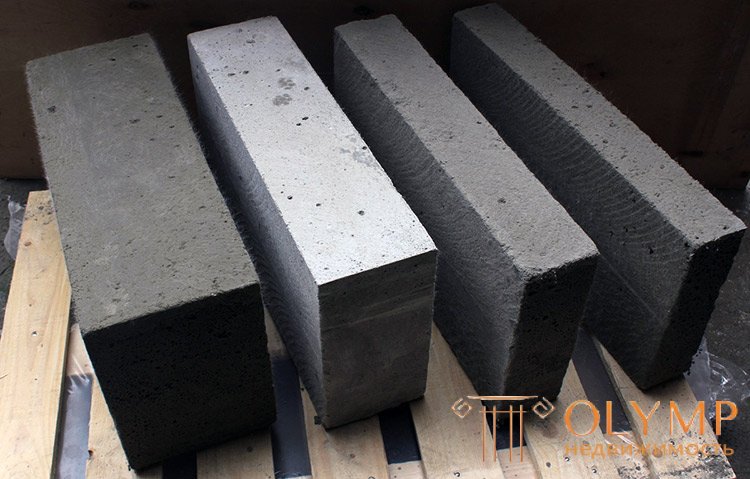 |
| Fig. 1. Blocks from foam concrete. The figure shows foam concrete blocks with dimensions (from left to right): 600 * 300 * 200 mm - wall, 600 * 300 * 150 mm - for interroom partitions, 600 * 300-120mm and 600 * 300 * 100 mm - for interior partitions from heavy foam concrete. The light gray block was made earlier and had time to dry, the dark gray blocks were photographed the day after they were made, and therefore they have excess water in their composition. |
Foam-concrete block with a density of 200 - 400 kg / m3 (D200-D400 brands):
Its purpose - to keep warm in the living room. These blocks are used only for the purpose of thermal insulation - they can insulate the wall of the house, both outside and inside. It can be laid out on the floor of the first floor, to then make a leveling screed of cement mortar. They can insulate the attic, or a flat roof. On thermal conductivity competes with mineral wool and polystyrene foam.
Foam-concrete block with a density of 500 - 600 kg / m3 (D500 - D600 brands):
The most popular in the market unit. The block thickness of 100-120 mm is used for partitions. Blocks 200-300 mm thick for the construction of low-rise buildings up to 2 floors high. The greatest number of such blocks is implemented to fill the curtain walls of frame buildings.
Foam-concrete block with a density of 700 - 800 kg / m3 (D200 - D400 brands):
Now the production of such blocks is quite limited, since their main use is the construction of buildings up to 4 floors high.
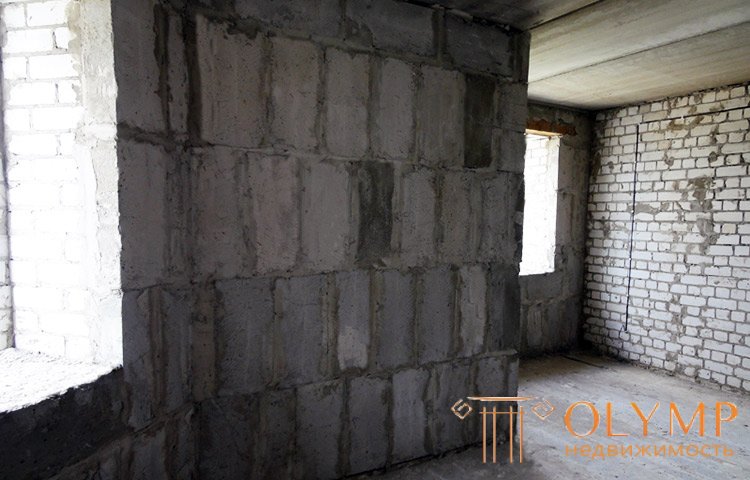 |
| Fig. 2. The use of blocks of thermal insulation "light" foam D300. The outer wall of a multistory building was insulated with foam concrete blocks with a density of D300 inside the building. The outer wall is made of bricks. The thickness of the insulation is only 120 mm. |
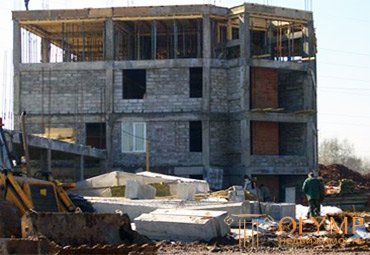 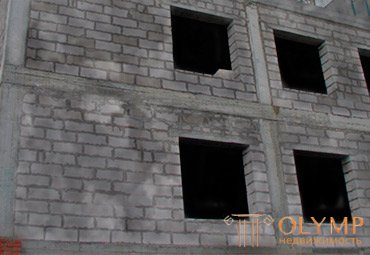 |
| Fig.3. Использование блоков из конструкционно-теплоизоляционного «среднего» по плотности пенобетона. Сейчас большинство зданий строится по каркасной технологии. На рисунке показано здание с железобетонным каркасом. Каркас может быть также металлическим. Наружные стены здания заполняются пенобетонными блоками Д500. Нагрузку в здании несет каркас, пенобетонная стена держит только свой вес в пределах одного этажа. |
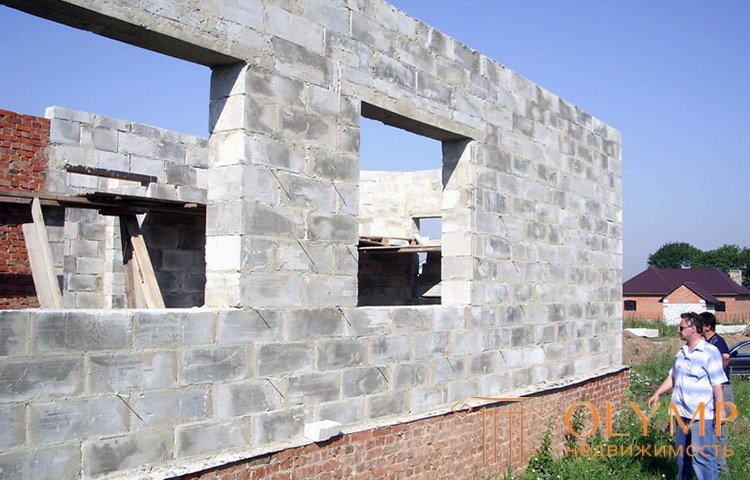 |
| Fig.4. Использование блоков из конструкционно-теплоизоляционного «тяжелого» пенобетона. На фотографии показана наружная несущая стена частного дома из пенобетонных блоков плотностью Д800. Перекрытия в доме будут железобетонные, здание строится в два этажа. Толщина несущей стены 300мм. Такой дом желательно дополнительно теплоизолировать снаружи или изнутри. |
Attention!
Белые пористые блоки, которые вы могли видеть на строительных площадках – это автоклавный газобетон или газосиликат. Автоклавный газобетон - основной конкурент пенобетона. Внешне он очень похож на пенобетон. Основное отличие автоклавных материалов – в составе сырья. Если пенобетон сделан на основе цемента, то автоклавные материалы делают на основе извести. А так как известь белая, то и газобетонные блоки имеют белый цвет. Красивый белый цвет это конечно интересная, но бесполезная на практике особенность газобетона.
Чем отличается неавтоклавный пенобетон от автоклавного газобетона?
Цементный неавтоклавный пенобетон твердеет при любой плюсовой температуре, а известковый газобетон только в автоклаве, при давлении 8 атмосфер и температуре 200 градусов. Цементный пенобетон, в отличие от материалов на основе извести не боится попадания воды, и в воде практически не намо-кает. Известковые газобетоны из автоклава быстро впитывают воду, теряя при этом прочность и способ-ность хранить тепло. Если конструкционные пенобетоны плавают в воде неограниченно долго и не намо-кают, то газобетон тонет через несколько часов, впитав в себя воду. Подводя итоги короткой строкой, скажем, что газобетон в целом немного прочнее пенобетона (так как твердеет в автоклаве). Вместе с тем, газобетон имеет значительно меньшую долговечность, чем пенобетон. Пенобетон со временем набирает прочность, газобетон - наоборот сбрасывает.
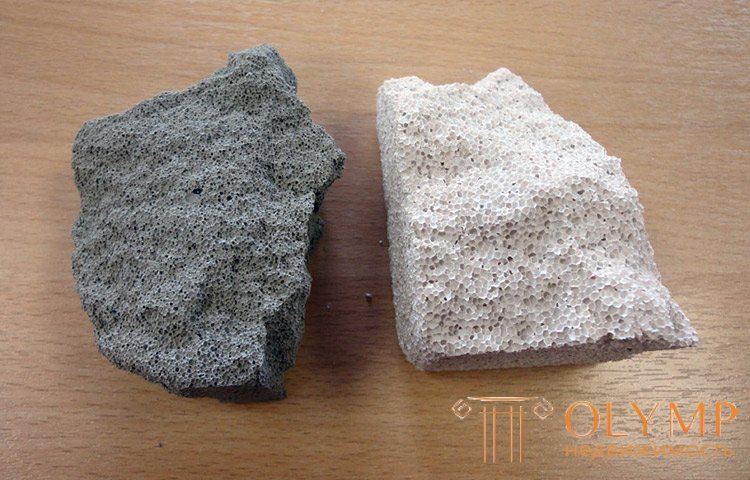 |
| Fig. 5. Foam concrete and gas silicate. Appearance. In the photo you see a break of the foam concrete block (left) and gas silicate (right). Foam concrete has a gray color, its pores are finer than pores of aerated concrete. The finer the time, the warmer the material. In addition, cement foam is much more durable than aerated lime. |
Monolithic foam concrete with a density of 200 - 400 kg / m3 (grade D200 - D400).
The lightest and warm foam concrete is used for pouring flat roofs, ground floor floors, wall wells, attics of pitched roofs. With this foam concrete it is possible to pour in house frames sheathed with gypsum plasterboard, glass-magnesium sheet, asbestos-cement sheet, etc. Frameworks can be made of plasterboard profile, light metal profile (LSTC), metal, wood, plywood, etc. The technology of building houses through the monolithing of the frame is one of the most inexpensive in the construction industry. And despite the obvious cheapness, such housing will be non-combustible, will not be exposed to damage by rodents and mold, will be warm and durable, will not be blown by the wind.
Monolithic foam concrete with density of 500 - 600 kg / m3 (grade D500 - D600)
Often used for leveling screeds on flat roofs. At the top of the layer of such foam concrete, you can safely roll up a roll of bitumen roofing or make a PVC membrane. Also used for the installation of leveling screeds with the subsequent laying of laminate and tile. From this foam concrete pour the bearing walls of cottages up to 2 floors high.
Monolithic foam concrete with a density of 700 - 800 kg / m3 (grade D200 - D400).
It is applied as a rule to make screeds with the subsequent laying of linoleum. Also from this foam concrete can be made bearing walls of low-rise buildings (up to 3, 4 floors) with reinforced concrete floors.
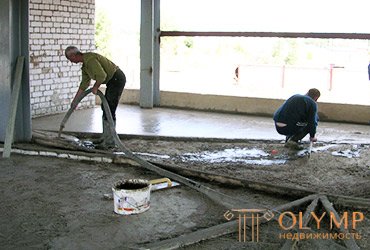  |
| Fig. 6.7. The use of structural "heavy" monolithic foam concrete. Filling foam concrete leveling screeds (instead of cement ones) with monolithic foam concrete with density D800. It is much easier to work with foam concrete than with cement mortar - it is easier to feed, it is easier to fit and rubbed, the foam concrete itself is lighter, warmer, and has a higher sound insulation. The only drawback is lower strength. |
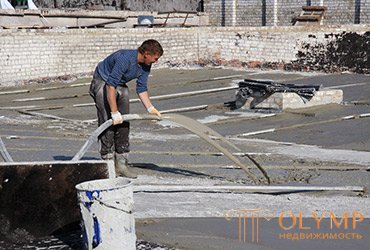  |
| Fig. 8.9. The use of heat-insulating or "light", and structural heat-insulating or "medium" monolithic foam concrete. Filling of flat roofs with monolithic foam concrete for leveling and thermal insulation. The roof is made of double-layer. The lower layer is heat-insulating, from foam concrete with a density of 250 kg / m3 - from 100 mm thick. The top layer of structural foam concrete with a density of 500 kg / m3 has a thickness of 30-40 mm. |
 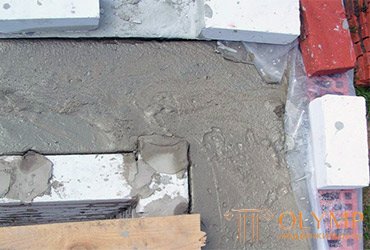 |
| Fig. 9,10. Use of heat-insulating "light" monolithic foam concrete. Filling the walls of a private house with lightweight insulating foam concrete of density d250. Filling is carried out in a “well” with an internal wall of silicate (white) brick and an external one of ceramic (red). Foam concrete is supplied to the place of work on the sleeve, the task of the worker is only to hold the sleeve during pouring and not to allow overflow of the concrete mix. |
Что бы оставить комментарий войдите
Комментарии (0)